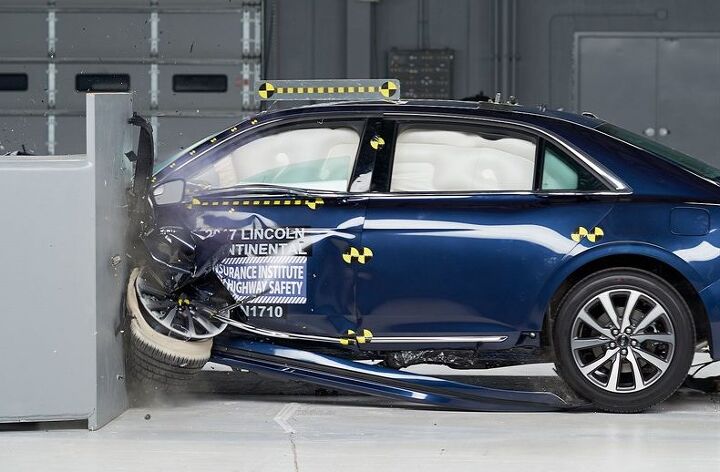These Large Cars Offer the Most Luxurious Crash Experience

Like the rest of North America’s passenger car market, full-size sedan sales are waning. While luxury vehicles haven’t taken quite the same hit as more affordable models, big cars are not in fashion for 2017. However, some buyers still prefer the distinction and mass that only a full-size automobile can provide. They want a luxurious, low-slung ride and, if possible, an equally elegant crash experience.
While big cars tend to perform better in accidents than the majority of their petite contemporaries, very few vehicles do well in the small overlap crash test. The Insurance Institute for Highway Safety recently took six of its favorite picks from the segment to evaluate side impact crashes, roof strength, protection from head restraints, moderate overlap front crashes, and the dreaded small overlap front impact.
“This group of large cars includes some with stellar ratings, but our small overlap front test remains a hurdle for some vehicles,” explained David Zuby, IIHS executive vice president and chief research officer.
Due to the massive amount of force focused on the narrow area directly in front of the driver, the IIHS believes small overlap wrecks account for at least one-quarter of the fatalities and serious injuries sustained in frontal impacts. Of the six cars, only the Lincoln Continental, Mercedes-Benz E-Class, and the Toyota Avalon earned a Top Safety Pick+ award.
While the Tesla Model S, Chevrolet Impala, and Ford Taurus all earned an acceptable rating for the front overlap test, they were already ineligible for Top Safety Pick+ honors due to their poor headlight ratings — something the IIHS has increasingly concerned itself with in recent years.
Meanwhile, E-Class and Continental both yielded a good headlight rating while the Avalon was deemed to have acceptable illumination. All the cars have been updated for the 2017 model year, except for the Continental, which is replacing the Lincoln MKS. The three sedans were also praised for their crash prevention systems.
However, that shouldn’t be taken as a slight to the Taurus, Impala, or Model S — all of which performed amicably but lacked in forward illumination and didn’t fare quite as well in the small overlap tests. The Ford’s absence of some modern crash avoidance technology was also a factor in keeping it from achieving top marks, primarily due it not possessing automatic emergency braking.
[Images: IIHS]

A staunch consumer advocate tracking industry trends and regulation. Before joining TTAC, Matt spent a decade working for marketing and research firms based in NYC. Clients included several of the world’s largest automakers, global tire brands, and aftermarket part suppliers. Dissatisfied with the corporate world and resentful of having to wear suits everyday, he pivoted to writing about cars. Since then, that man has become an ardent supporter of the right-to-repair movement, been interviewed on the auto industry by national radio broadcasts, driven more rental cars than anyone ever should, participated in amateur rallying events, and received the requisite minimum training as sanctioned by the SCCA. Handy with a wrench, Matt grew up surrounded by Detroit auto workers and managed to get a pizza delivery job before he was legally eligible. He later found himself driving box trucks through Manhattan, guaranteeing future sympathy for actual truckers. He continues to conduct research pertaining to the automotive sector as an independent contractor and has since moved back to his native Michigan, closer to where the cars are born. A contrarian, Matt claims to prefer understeer — stating that front and all-wheel drive vehicles cater best to his driving style.
More by Matt Posky
Latest Car Reviews
Read moreLatest Product Reviews
Read moreRecent Comments
- ToolGuy 9 miles a day for 20 years. You didn't drive it, why should I? 😉
- Brian Uchida Laguna Seca, corkscrew, (drying track off in rental car prior to Superbike test session), at speed - turn 9 big Willow Springs racing a motorcycle,- at greater speed (but riding shotgun) - The Carrousel at Sears Point in a 1981 PA9 Osella 2 litre FIA racer with Eddie Lawson at the wheel! (apologies for not being brief!)
- Mister It wasn't helped any by the horrible fuel economy for what it was... something like 22mpg city, iirc.
- Lorenzo I shop for all-season tires that have good wet and dry pavement grip and use them year-round. Nothing works on black ice, and I stopped driving in snow long ago - I'll wait until the streets and highways are plowed, when all-seasons are good enough. After all, I don't live in Canada or deep in the snow zone.
- FormerFF I’m in Atlanta. The summers go on in April and come off in October. I have a Cayman that stays on summer tires year round and gets driven on winter days when the temperature gets above 45 F and it’s dry, which is usually at least once a week.


































Comments
Join the conversation
Most of the complaints I've heard about headlights today has to do with the intense brightness of the projector beam style. Any rise, bump or other body movement will put the full beam into an oncoming driver's eyes.
"Amicably" is the wrong word. "Ford's absence" is clumsy and wrong.